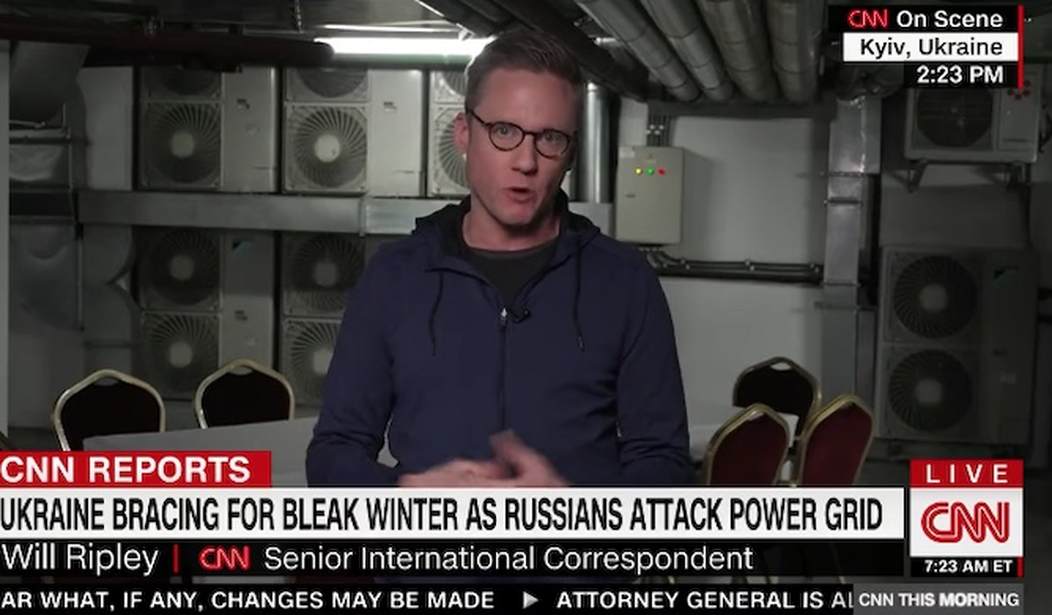Has Ukraine decided to go on the offensive to knock out Russian air capabilities to stop the attacks on its civilian infrastructure? Or has Vladimir Putin conducted false-flag operations to bolster domestic support for a war that may end up producing a popular revolt?
One way or the other, it’s about to get interesting:
Explosions rocked two air bases in Russia on Monday, Russian media reported. One of the explosions reportedly happened at a base that houses nuclear-capable strategic bombers that have been involved in launching strikes against Ukraine.
Neither Ukrainian nor Russian authorities immediately commented on the possible cause of the blasts.
Russian state RIA Novosti news agency said three servicemen were killed and six others injured, and a plane was damaged, early Monday when a fuel truck exploded at an air base in Ryazan, in western Russia. The base houses long-range flight tankers that serve to refuel bombers in the air.
Separately, authorities in the Saratov region along the Volga River said they were checking reports about an explosion in the area of the Engels air base, which houses Tu-95 and Tu-160 strategic bombers that have been involved in launching strikes on Ukraine. Those bombers are capable of carrying nuclear weapons.
Emphasis mine. Putin has talked openly about the use of tactical nuclear weapons in response to Ukrainian battlefield successes, although he’s been pretty quiet about it lately. Is this an attempt by Putin to justify using such weapons in Ukraine? Or perhaps an attempt by Kyiv and Volodymyr Zelensky to prevent it?
If it’s part of an attack by Ukraine, it’s an impressive one — which is one reason for skepticism. Ryazan is relatively close to Moscow but to its southeast, and over 400 road miles from the Ukrainian border. Engels is even further southeast and well over 500 road miles from Luhansk. How did Ukrainian forces get close enough to either base for such a strike? It certainly couldn’t have been an air attack, and both targets are well out of range for any missiles Ukraine’s using at the moment. Ukraine might have sabotage teams operating in Russia, but that seems like a long way to go to find a good target. Usually those kinds of teams target ground lines of communication much closer to the actual fighting.
Ryazan’s close enough to Moscow to get a big response from Russian media and the rumor mill, though. That’s something to keep in mind.
If it’s a real attack by Ukraine, though, they have good reasons to push the war against Russia proper. Putin has begun yet another missile offensive today on their power generation infrastructure, and it’s a matter of life and death for Ukraine’s civilian population:
#breaking We're broadcasting from an underground shelter in Kyiv. The Ukrainian military confirms a Russian missile attack is underway & air defense systems activated. Last week, Ukraine's FM warned of a looming 'major attack' on the power grid, as Winter approaches. @donlemon pic.twitter.com/k6p4BqUAXQ
— Will Ripley (@willripleyCNN) December 5, 2022
The Ukrainian air defenses are performing well, but Russia is attempting to overwhelm it through sheer numbers. Eventually Russia will run out of missiles, but “eventually” doesn’t sound very good when it comes to watching women and children die in explosions and families freezing to death. And for that matter, eventually Ukraine will run out of anti-aircraft ammunition unless the West starts manufacturing more on a far larger scale than we are at present. The better way to shield Ukraine from these attacks is to go after their air bases and force Russia back onto a defensive, or at least knock them a little off balance.
Will that expand the war? Maybe, but at least in terms of conventional warfare, it’s not going to get expanded much more as it is. Russia is conducting these missile attacks because its ground forces are more or less spent, and their naval assets are too much at risk for close engagement. Right now, the Kremlin’s big hope is that Ukraine decides to wait out the winter to allow Russia time to reorganize its forces. Ukraine’s response to this is classic:
The Ukrainian Ministry of Defense (MoD) stated on November 20 that those who suggest the winter will pause hostilities “likely never sunbathed in January on the southern coast of Crimea,” suggesting that Ukrainian forces intend to continue counteroffensive operations over the coming winter that contribute toward the goal of retaking Crimea.[3] Ukrainian Deputy Defense Minister Volodymyr Havrylov stated on November 18 that Ukrainian forces will continue to fight in the winter because any type of pause will allow Russian forces to reinforce their units and positions.[4] Ukrainian officials’ prior statements on ongoing Ukrainian counteroffensive actions in Kherson Oblast are further evidence that these official statements on winter counteroffensive actions are indicators of continuing counteroffensive operations.[5]
Senior US government officials are mistakenly identifying the optimal window of opportunity for Ukraine to conduct more counteroffensives as the spring rather than winter, despite Ukrainian officials’ statements to the contrary. US Director for National Intelligence (DNI) Avril Haines assessed on December 3 that the pace of the war in Ukraine will slow over the winter so both sides can refit, resupply, and reconstitute, despite evidence that conditions on the ground favor a renewed offensive and despite the demonstrated tendency of Ukrainian forces to initiate new counteroffensive efforts relatively quickly after the previous effort has culminated.[6]
Ukraine’s ability to maintain the military initiative and continue the momentum of its current operational successes depends on Ukrainian forces continuing to conduct successive operations through the winter of 2022-2023. Russia lost the initiative in summer 2022 after its offensive in Donbas culminated.[7] Ukrainian forces gained and have retained the initiative since August 2022 and have been conducting a series of successful successive operations since then: Ukraine liberated most of Kharkiv Oblast in September, Kherson City in November, and is currently setting conditions for more Ukrainian pushes elsewhere this winter.[8] Successive operations are a key part of Ukraine’s campaign design. A series of successive Ukrainian counteroffensive operations in Kharkiv and Kherson oblasts demonstrates the Ukrainian military‘s remarkable operational planning skill and knowledge of the strengths of Soviet operational art. Soviet operational art emphasizes that militaries can only obtain their strategic objectives through the cumulative operational success of successive operations ideally conducted without operational pauses between them.[9] Recent official Ukrainian statements make clear that Ukraine’s campaign design is designed to allow a series of successive operations to deprive Russia of the initiative, defeat the Russian military, and liberate more Ukrainian territory.
The big question now will be whether Putin renews his threats of nuclear response in retaliation for whatever happened at Ryazan and Engels. It won’t improve his tactical positions, which are failing, nor help military units incapable of coordination with other conventional forces, let alone unconventional. Putin’s only hope with such a move is to scare off Ukraine’s allies with a nuclear blast, but it’s likely to remind everyone of the need to contain Russia on a permanent basis rather than convince NATO to retreat. And China might rethink its forever friendship with Putin at that point, too.








